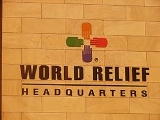
World Relief
Encyclopedia
World Relief is an international relief and development agency. Founded in 1944 as the humanitarian arm of the National Association of Evangelicals, World Relief offers assistance to victims of poverty, disease, hunger, war, disasters and persecution. Headquartered in Baltimore, Maryland, the organization has offices worldwide. It is supported by churches and individual donors, as well as through United States Government grants from USAID and other agencies.
World Relief’s core programs focus on microfinance, AIDS prevention and care, maternal and child health, child development, agricultural training, disaster response, refugee resettlement
and immigrant services.
established the War Relief Commission to send clothing and food to victims of World War II. After the war, evangelical leaders decided that the War Relief Commission should continue because needs were still great in post-war Europe and around the world. In 1950, the agency was renamed World Relief, and began to focus on other areas of development – providing sewing machines and training so war widows could earn a living, setting up TB clinics, and supporting orphanages and land reclamation projects.
In 1961, World Relief’s former chairman, C.N. Hostetter, Jr., served as a member of President Kennedy’s “Food for Peace” committee to help distribute food to destitute regions of the world. World Relief moved beyond providing emergency relief in response to disasters, working to foster long-term development to help the poor rise above subsistence. The agency offered individuals small loans called Life Loans – the precursor to its current microfinance activities.
From the 1960s through the 1980s, World Relief continued to respond to food-related emergencies around the world. The agency also began serving refugees worldwide – including refugees from Vietnam and the Balkans.
In 1969, the United States Marines in Vietnam turned over the Hoa Khanh Children’s Hospital in Da Nang to World Relief. It became World Relief’s biggest project in Vietnam, providing care for more than 125,000 patients before World Relief was forced to evacuate in 1975.
World Relief’s core programs focus on microfinance, AIDS prevention and care, maternal and child health, child development, agricultural training, disaster response, refugee resettlement
VOLAG
VOLAG, sometimes spelled Volag or VolAg, is an abbreviation for "Voluntary Agency". This term refers to any of the ten U.S. private agencies and one state agency that have cooperative agreements with the State Department to provide reception and placement services for refugees arriving in the...
and immigrant services.
History
World Relief began in 1944 when American Christian denominations partnered with sister churches in war-torn Europe to address critical humanitarian needs. The National Association of EvangelicalsNational Association of Evangelicals
The National Association of Evangelicals is a fellowship of member denominations, churches, organizations, and individuals. Its goal is to honor God by connecting and representing evangelicals in the United States. Today it works in four main areas: Church & Faith Partners, Government Relations,...
established the War Relief Commission to send clothing and food to victims of World War II. After the war, evangelical leaders decided that the War Relief Commission should continue because needs were still great in post-war Europe and around the world. In 1950, the agency was renamed World Relief, and began to focus on other areas of development – providing sewing machines and training so war widows could earn a living, setting up TB clinics, and supporting orphanages and land reclamation projects.
In 1961, World Relief’s former chairman, C.N. Hostetter, Jr., served as a member of President Kennedy’s “Food for Peace” committee to help distribute food to destitute regions of the world. World Relief moved beyond providing emergency relief in response to disasters, working to foster long-term development to help the poor rise above subsistence. The agency offered individuals small loans called Life Loans – the precursor to its current microfinance activities.
From the 1960s through the 1980s, World Relief continued to respond to food-related emergencies around the world. The agency also began serving refugees worldwide – including refugees from Vietnam and the Balkans.
In 1969, the United States Marines in Vietnam turned over the Hoa Khanh Children’s Hospital in Da Nang to World Relief. It became World Relief’s biggest project in Vietnam, providing care for more than 125,000 patients before World Relief was forced to evacuate in 1975.

